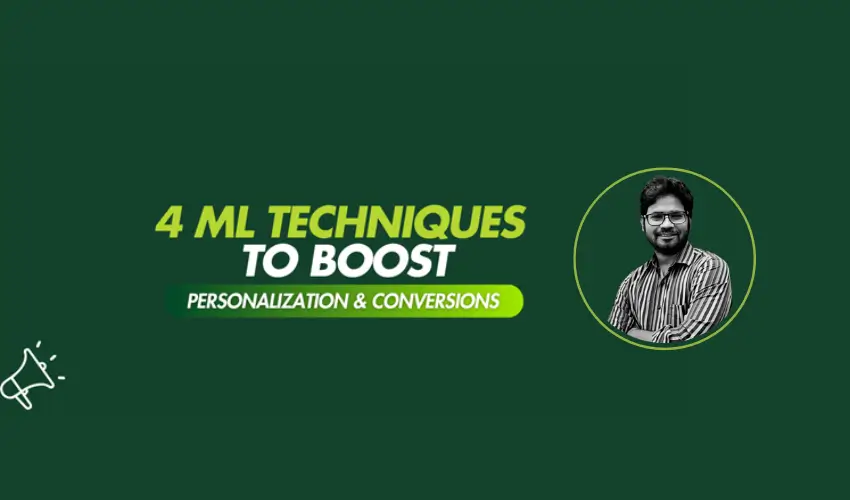
4 Machine Learning Techniques to Boost Personalization and Conversions
Have you ever noticed that some brands just get you? What is the feeling when you open Netflix and it suggests a show that allegedly fits your mood, or when Amazon suggests that thing you didn’t know you needed but now can’t wait to purchase? In a way, it feels like magic, but magic itself is not sheer luck. That’s smart personalization at work.
Personalization is no longer a bonus in today’s fast-paced digital world. People now expect that. With so many choices to choose from, customers will go somewhere else if a brand is not relevant to them. As a result, personalization has become a big deal for marketers and sales teams. It’s not only about giving people the illusion of being seen; it’s about driving real results. In fact, companies that do personalization drive up to 40% more revenue than their competitors.
But how are they able to pull it off? The answer is machine learning. With real data and patterns, it helps companies understand their customers. Rather than guessing what people want, machine learning learns from what people actually do and like, and then serves up experiences that feel tailor-made.
In this blog, we are going to talk about 4 interesting ways machine learning can help you make your personalization and conversion better. We’ll look at how recommendation systems can suggest the right thing at the right time, how predictive analytics can anticipate what the next thing a customer needs, how natural language processing can make sense of what people are saying, and how clustering can help us understand different types of customers better.
-
Recommendation Systems
Having seen how personalization is supported by machine learning, let’s begin with one of the most exciting applications of this: recommendation systems. Have you ever watched one more YouTube video or listened to another Spotify playlist that seems to know your taste? Well, you’ve already seen personalization in action.
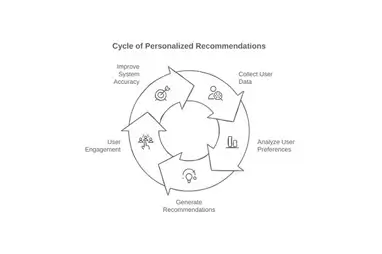
A recommendation system suggests things that you might like or need based on what you have previously done. It learns from what you have watched, clicked, liked or bought and then it uses this knowledge to suggest something new. Some systems look at people with similar interests, and others look directly at your own preferences. Many combine both to enhance accuracy. What makes them so powerful is that they can transform everyday actions into smart suggestions. The system gets more data every time someone scrolls or searches, and it gets better. The experience becomes more personal and engaging over time.
Personalized recommendations can help reduce cart abandonment by more than 4 percent. In fact, more than half of consumers now expect brands to tailor offers to their interests, which demonstrates how important this is.
A good example is Spotify’s Discover Weekly playlist. It learns what the listeners already like and introduces them to new music. By lining up videos that match their viewing habits, YouTube also keeps people watching longer. This all leads back to what we talked about earlier. People will stay engaged when experiences feel tailored, and recommendation systems allow this to happen in a way that feels natural and effortless.
-
Predictive Analytics
Up until now, we have seen how recommendation systems learn from what people already like to recommend the next best thing. So what if we could actually predict what someone might want or do next? Here, Predictive analytics comes into play, adding a deeper, more insightful layer to personalization.

In the case of predictive analytics, historical data is used to predict future behavior. It guesses what customers may do in the future by identifying patterns in what they have done in the past. This allows marketers to know who’s most likely to buy, who might respond to a particular offer, or even who might stop engaging. It gives brands the foresight to create messages and campaigns with more timing and intent. Through this, marketers can act early, and make experiences that feel intuitive and relevant, instead of reacting to customer actions.
Also, the results are quite impressive. Businesses using predictive analytics have seen a 10 to 15 percent increase in their marketing ROI. Some report sales lifts as high as 73 percent above what they would be without it.
Even Coca-Cola uses predictive models to plan and optimize its marketing spend to make sure its campaigns reach the right people at the right time.
-
Natural Language Processing (NLP) for Personalization
Just as predictive analytics allows us to predict what customers will do next, there’s another machine learning area that allows us to understand what they are saying. This is called natural language processing (NLP) and it’s one of the most interesting tools in the personalization toolkit.
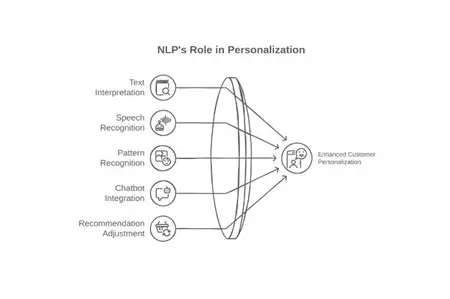
Machines understand human language with the help of NLP. It can interpret and understand all types of text and speech data, such as reviews and support chats. What’s impressive here is its ability to recognize patterns and meaning in what people are already saying. This allows businesses to understand the needs, feelings and intentions of their customers.
Brands can refine their communication, adjust their recommendations and respond in a way that feels thoughtful by listening closely. NLP can pick up if someone says a product feels too tight in a review and help the system get better at what it suggests next. When multiple users ask for the same feature, it’s a clue as to what matters most.
Many modern chatbots are also powered by NLP. Rather than giving generic replies, the best ones now reply in a way that seems human and helpful. They answer questions and adjust as someone interacts with them. The experience itself is what makes support feel more personal and faster. It isn’t surprising that more businesses are turning to NLP in customer service. The projection for 2025 is that AI, especially NLP-based solutions, will lead the way for half of all customer support. Even some companies, including H&M, now look at reviews to adjust their recommendations, so customers see buying options that matter to them.
-
Customer Segmentation Using Clustering Algorithms
Having learnt how machines understand customer language, the next step is to understand how they group customers and make personalization even sharper. This is where clustering comes in, and it is very powerful in the sense of finding hidden patterns in the behavior.
Clustering enables machines to find out, without being told, which customers belong together by what they do, not who they are. It looks for natural similarities of actions and preferences. Clustering can detect these habits, such as how often someone shops, what categories they browse, and when they engage, and make meaning out of them in the form of segments.
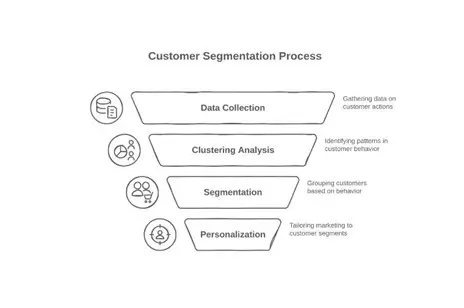
This is beyond the traditional segmentation methods, such as age or location. The fact that it is based on real behavior makes the resulting campaigns feel much more real than other marketing tactics. If you know how different groups interact with your product or service, you can easily communicate with their needs and interests. The results are very noticeable. Firms that practice advanced segmentation usually notice an increase in their revenue. Most marketers say their messages get a better response when they are guided by these data-based groups.
Starbucks is one of the companies that uses clustering to offer custom deals based on how people spend. Similarly, Netflix achieves this by grouping content into micro-genres, making it easy for viewers to find something they like without searching.
Clustering helps to make personalization more effective. While recommendation systems suggest, predictive analytics anticipates, and NLP listens, clustering helps companies find out what their customers do. By doing this, the entire process of personalization is made more efficient and targeted.
The Engine Behind Personalization
Now that we’ve seen how all these techniques work, we can explore the tools that make them visible on the web. This is where web personalization platforms become essential. They use machine learning to make experiences feel unique for each person in real time.
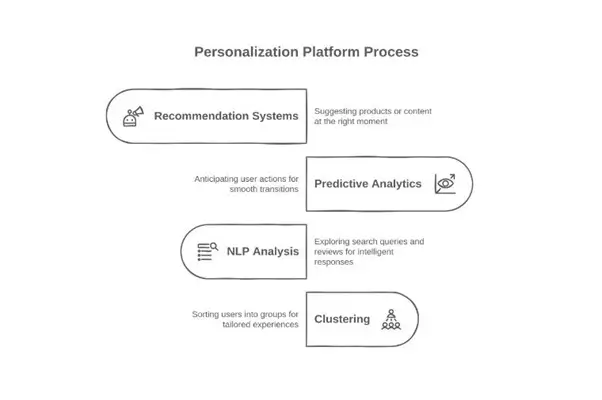
These platforms use recommendation systems to show the right products or content at the right moment. Using predictive analytics, they know what the next action could be and modify the site to ensure a smooth transition. They make use of NLP to explore on-site search queries, reviews, and even chats with chatbots, so they can respond more intelligently. And through clustering, they automatically sort users into different groups and give each group the best website experience.
Everything we have discussed thus far is directly pertinent to how these platforms work. They allow businesses to step beyond an off-the-shelf website and into a world where every visitor sees something just a bit more relevant, a bit more engaging. At the end of the day, great personalization means using intelligence behind the scenes to create a seamless, intuitive experience on the front end.
Conclusion
Through machine learning, businesses have acquired some powerful ways in which they can personalize at scale. Whether it is delivering more tailored recommendations, predicting users’ behaviour, understanding the customer language, or segmenting the user audience in real time, all of the techniques build on top of one another to further enhance the personalization journey. Used together, they deliver seamless, intuitive experiences that are natural for the customer and measurable for the business.
These are the same strategies that all of today’s digital leaders use to succeed. But what really makes them unique is that they have not only access to these advanced tools, but also the ability to use data to their advantage, to be responsive to how their customers behave, and use these with intention. For any organization willing to walk the same path, the road to higher levels of engagement, loyalty, and conversion is already taking shape.
Author Bio
Vidhatanand is the Founder and CEO of Fragmatic, a web personalization platform for B2B businesses. He specializes in advancing AI-driven personalization and is passionate about creating technologies that help businesses deliver meaningful digital experiences.